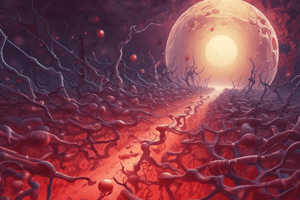Podcast
Questions and Answers
What is the primary function of hemostasis in the body?
What is the primary function of hemostasis in the body?
- To reduce blood vessel diameter
- To promote blood clotting
- To prevent blood loss and maintain blood fluidity (correct)
- To increase blood pressure
What is the result of defects in hemostasis?
What is the result of defects in hemostasis?
- Increased blood pressure
- Decreased risk of bleeding
- Improved blood vessel elasticity
- Increased risk of bleeding or clotting (correct)
What is the primary hemostasis?
What is the primary hemostasis?
- Formation of platelet plug (correct)
- Dissolution of fibrin clot
- Conversion of fibrinogen to fibrin
- Vascular constriction
What is the role of thrombin in the coagulation cascade?
What is the role of thrombin in the coagulation cascade?
What is the purpose of the fibrinolytic system?
What is the purpose of the fibrinolytic system?
What is the definition of bleeding time?
What is the definition of bleeding time?
What is the activator of the coagulation cascade?
What is the activator of the coagulation cascade?
What is the product of the conversion of fibrinogen in the coagulation cascade?
What is the product of the conversion of fibrinogen in the coagulation cascade?
Flashcards are hidden until you start studying
Study Notes
Hemostasis Physiology
- Hemostasis is the process of forming clots in damaged blood vessels to prevent blood loss while maintaining blood fluidity within the vascular system.
- Defects in hemostasis can lead to increased risk of bleeding (hemorrhage) or clotting (thrombosis).
Events in Hemostasis
- Vascular constriction: damaged blood vessels constrict.
- Formation of platelet plug: platelets adhere to damaged endothelium to form a platelet plug (primary hemostasis).
- Blood coagulation: clots form upon the conversion of fibrinogen to fibrin, and its addition to the platelet plug (secondary hemostasis).
The Clotting Mechanism
- The intrinsic pathway involves collagen, XII, XI, IX, VIII, and X.
- The extrinsic pathway involves tissue thromboplastin, VII, X, and V.
- Fibrinogen (I) is converted to fibrin, leading to the formation of a blood clot.
- Prothrombin (II) is converted to thrombin (III), which facilitates the conversion of fibrinogen to fibrin.
Fibrinolytic Phase
- The fibrinolytic system prevents the growth of a fibrin clot, which would cause serious complications.
- Fibrinolysis (dissolving of fibrin fibers) is brought about by the formation of active enzyme plasmin from plasminogen.
Bleeding Time (B.T.)
- Definition: the time interval between skin puncture and spontaneous, unassisted stoppage of bleeding.
Studying That Suits You
Use AI to generate personalized quizzes and flashcards to suit your learning preferences.




